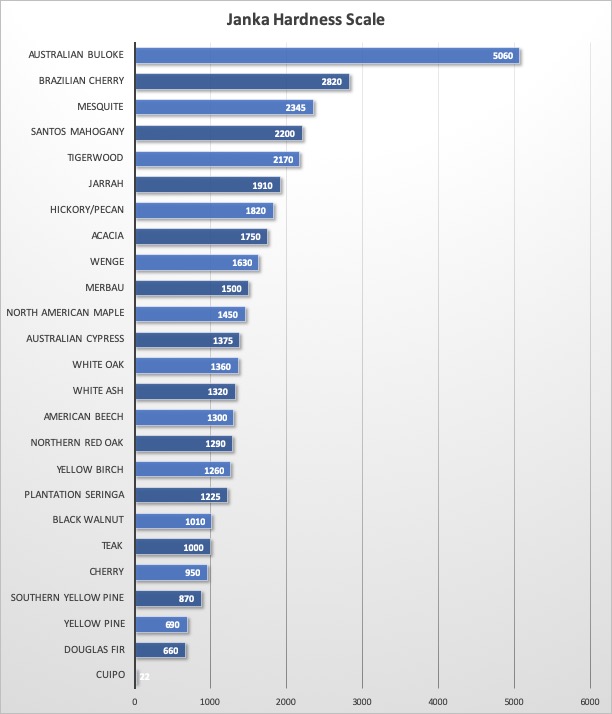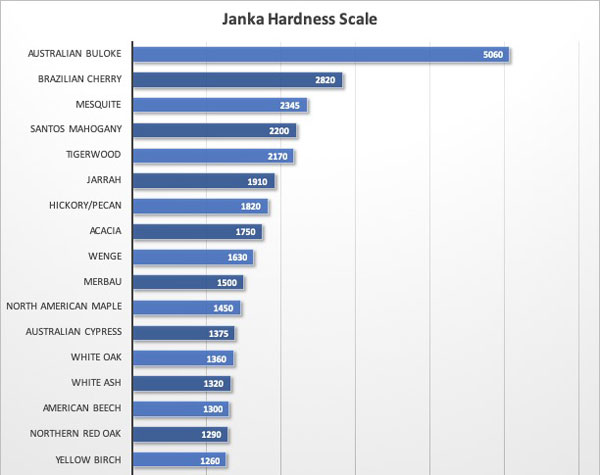Most of the following story is true.
There once was a man named Gabriel from Austria who pondered some of the great questions in life. Perhaps the greatest among these questions was the simple, yet diabolically complex query “just how hard is wood?” Gabriel worked tirelessly to find answers. Eventually, he adapted a test from another great thinker of hard thoughts- a Swedish fellow named Brinell- to suit his purposes. He would dub his work the “Janka Hardness Test,” since Janka was his last name and the “Wie Hart Ist Dieses Holz” Hardness Test was just a mouthful and a half.
At this point, you’re most likely either trying to translate German or asking yourself: “Why does any of that matter to me?” Either way, I applaud your curiosity.
Truthfully, knowing the “based on real events” version of Gabriel Janka’s life and work probably won’t have much impact on your day to day life. But if you are in the market for a hardwood floor, understanding the Janka Hardness Scale can make a massive difference.

The basic idea that some things are harder than others is pretty simple to understand. Both diamonds and the graphite in pencils are crystalline carbon. The difference in hardness between the two is pretty profound. Consequently, it’s not difficult to differentiate between them.
Wood follows the same principle. Some types are simply harder than others. The issue is: there are over 60,000 species of trees in the world, and determining which one is going to make the perfect floor for your space can be tricky. Do you need a wood that is as hard as steel? Probably not. Can I interest you in a wood you can push a quarter into with your bare hand? Doubtful. Much like the fabled blonde-haired, porridge stealing, home invader of grizzly bears, you want something in the middle. Something “just right.” This is where Mr. Janka steps in and introduces you to his namesake test.
In its most simple terms, the Janka Hardness Test is seeing how much effort it takes to push a steel ball into a piece of wood. Once the .44” ball is half of its diameter deep – the measurement of the force used to reach said depth is taken and written down. After some repetition and testing from different sides- the average of all the tests becomes the wood’s Janka Rating.

For hardwood floors, the industry median is set at about 1290 on the Janka scale. This happens to correspond to Northern Red Oak. There is an abundance of wood species options on either side of that standard from which you can choose your floor. Understanding the day-to-day activity that will take place on your floor will help you make the best choice for your space.
 Here is a fun bit of applied physics for you. The average African Elephant weighs in at about 12,000 pounds. The average 9-year-old clomping around in an adults high-heels weighs 63 pounds. Imagine both are about to take a stroll across your floor… which are you more worried about?
Here is a fun bit of applied physics for you. The average African Elephant weighs in at about 12,000 pounds. The average 9-year-old clomping around in an adults high-heels weighs 63 pounds. Imagine both are about to take a stroll across your floor… which are you more worried about?
The elephant gets the early start. It strolls leisurely around your space making polite mental notes about your décor and the interesting moment it finds itself in. You notice that it always keeps 2 of its massive feet on the ground when walking. You also note a distinct lack of damage to your floor.
The 9-year-old, however, is a different story altogether. Taken with the excitement of an elephant, the child jumps and skips about the room in its unfortunate (yet stylish) choice of footwear. You notice that this kid is an adorable sort of lunatic who never keeps two of anything on the ground at the same time. You then take note of the new dents and dings in your floor and begin to reconsider your earlier “adorable” assessment of the little so and so.
The math works out like this: the elephant, while huge, spreads its weight out placing about 150 pounds per square inch on your floor. The fashion-forward child ends up placing just over 1000 pounds per square inch with every high heel hop.
What it all boils down to is that seemingly mundane activity can have a big impact on the life of your floor. Understanding that fact and preparing for it, will ultimately save you time, energy, sanity and money in the long run. The Janka Hardness Scale is a resource for you to use to make the best possible choice when it comes to your floor.
For more tools, tips or knowledge to help you on your quest for a new hardwood floor, please visit our Floors 101 page or see our frequently asked questions. You can also request 3 free samples of any of our flooring products, find local retailers, or contact our team of flooring experts to answer your lingering questions.


